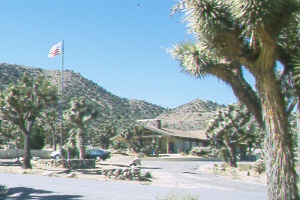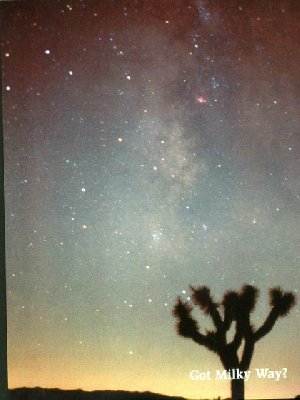|
AstroMax
|
|||
|
||||
| |||||||||
|
AAAA Attends Starry Nights FestivalOctober 16-18, 1998Presented by the Town of Yucca Valley,
California
|
Black Rock Canyon
|
 |
Yucca Valley is a 125 mile drive from the Long Beach airport. It took me almost three hours to get there on those parking lots they call freeways in Southern California. But even at that distance, you are not far enough away from the light glow of the LA area. The lights from LA 100 miles to the west were easily visibile. But, due to the exceptional transparency, the glow did not hamper overhead observing.
Observing at Black Rock Canyon Campsite, in the Joshua Tree National Park, began each evening at 8:00 p.m. The early part of the evening, up to about 10:00 p.m., was open to the public. After that, it was dark sky observing for those who brought telescopes.
If you were not camping at the site, the Festival did not allow you to bring in your own car. Instead, there were shuttle busses running from a parking lot about two miles away from the observing area. Busses ran about every 10 minutes up until 10:00. When I arrived, the parking lot was already full. But the whole thing was very organized and convenient, including a vendor area to buy Starry Night Festival Souveniers on your way in or out. I bought a poster and a coffee mug on my way home that night.
I got off the bus at the Visitor Center of the National Park. There was an Introductory Slide Show designed for the general public going on there. Wayne Johnson was the presenter, and it was packed. I did not stay for the whole thing; since there were so many people, I decided to give up my seat to someone else.
 It was just a short walk from the Visitor Center to the viewing area. People
were milling about everywhere, and the whole area was swarming with folks. There were long lines at all the telescopes,
so I picked one at random and waited my turn. When I go to the eyepiece, it turned out to be a guy with a DS-16
focused on Comet Giacobini-Zinner. This is a comet close to my heart, since way back in the 80ís, it was the first
comet I took a picture of. The view was very nice, but the comet was not very bright. When I asked the owner of
the scope where I could fine it with binoculars, he laughed and said it was too dim. However, he was kind enough
to tell me where to look in Ophiucus. When I did, I found out he was right, since I saw nothing but ordinary sky.
It was just a short walk from the Visitor Center to the viewing area. People
were milling about everywhere, and the whole area was swarming with folks. There were long lines at all the telescopes,
so I picked one at random and waited my turn. When I go to the eyepiece, it turned out to be a guy with a DS-16
focused on Comet Giacobini-Zinner. This is a comet close to my heart, since way back in the 80ís, it was the first
comet I took a picture of. The view was very nice, but the comet was not very bright. When I asked the owner of
the scope where I could fine it with binoculars, he laughed and said it was too dim. However, he was kind enough
to tell me where to look in Ophiucus. When I did, I found out he was right, since I saw nothing but ordinary sky.
I forgot my own binoculars on this trip. You know how it can be when trying to get out of town on an airplane. But Tim Hunter was kind enough to lend me his 8.5x44 Swift binocs, so I did quit a bit of casual binocular observing on the site, in between scopes. That night, I was able to observe M31, NGC 253, the Double Cluster in Perseus, and the Pleides rising in the east. I even saw the constellation Grus floating over the hill to the south. I think I got the best binocular view I have ever had of M31 through Timís binoculars. The air was extremly steady and transparent and M31 was directly overhead. I could see the definite outline of the edges of the galaxy. Later, I viewed M31 through one of the scopes, and was able to help its owner identify M32 and M110.
Lance Shaw from the Oakland Bay area was there with a large scope. I forget what kind of scope it was, but he was showing people M57, the Ring Nebula, and having a great time. I also remember viewing M27, the Dumbell Nebula, through one of the scopes, and seeing the central star. I think it was the same DS-16 through which I had seen the comet earlier that evening!
Unfortunately, I only spent 1.5 hours at the observing site, since the last bus back to parking left at 9:45, and I did not want to walk 2 miles. At that point, I could have driven back to the Visitor Centger parking lot, but I was already tired, and did not have my own scope, so I went back to the hotel.
Southern California is 2 hours earlier than Texas, and my body clock did not change while in Yucca Valley. So every morning, I woke up at 5:00 a.m. This is not something I normally do back home, so I took the opportunity to do a bit of early morning observing. Each morning, the waning moon, rising behind the Joshua Trees was a magnificent sight, just as dawn broke. It was fun to visit old friends like Canis Major, and Orion with the binoculars.
It was cold on the Hi-Desert, and a brisk wind did not help. But after the long hot summer in Texas, a bit of winter was a refreshing change. Temperature was in the high 60ís during the day, and got down into the 40ís at night. Saturday night was less windy, so it did not seem so cold.
Yucca Valley is essentially a distant suburb of LA, and the town has discovered one commodity it can sell to the light polluted city astronomers: Dark Skies! So it sponsors the Starry Nights Festival during a slow part of the tourist season. WRAL is fortunate to have such a good friend. But not too many folks from Northern California were able to attend, and most of those that did did not bring scopes. It is unfortunate that there is not more participation statewide in California, rather than just regionally.
Ed Flaspoehler
Vice-President, AAAA
| ||||||||